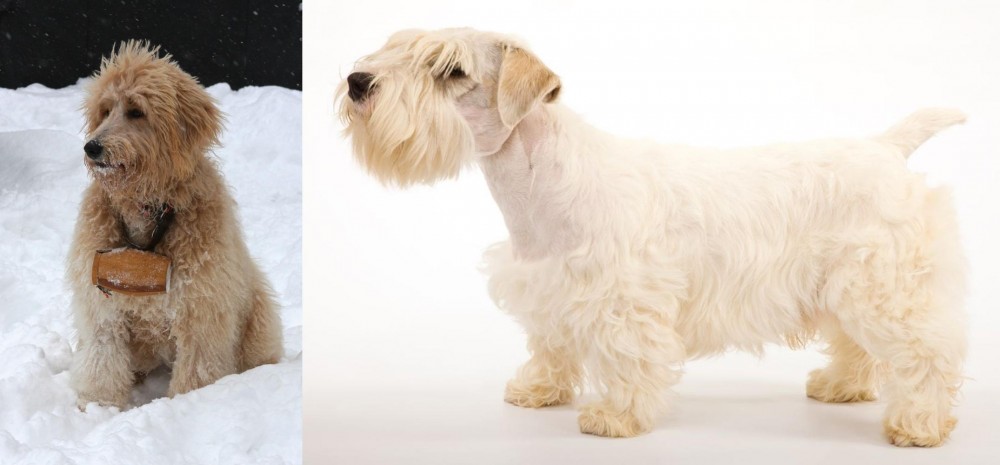 Petzlover
Petzlover Pyredoodle is originated from United States but Sealyham Terrier is originated from United Kingdom. Pyredoodle may grow 56 cm / 23 inches higher than Sealyham Terrier. Pyredoodle may weigh 37 kg / 82 pounds more than Sealyham Terrier. Both Pyredoodle and Sealyham Terrier has almost same life span. Both Pyredoodle and Sealyham Terrier has almost same litter size. Both Pyredoodle and Sealyham Terrier requires Moderate Maintenance.
Pyredoodle is originated from United States but Sealyham Terrier is originated from United Kingdom. Pyredoodle may grow 56 cm / 23 inches higher than Sealyham Terrier. Pyredoodle may weigh 37 kg / 82 pounds more than Sealyham Terrier. Both Pyredoodle and Sealyham Terrier has almost same life span. Both Pyredoodle and Sealyham Terrier has almost same litter size. Both Pyredoodle and Sealyham Terrier requires Moderate Maintenance.
 These dogs only originated in the 1980s, and as a designer dog they are a cross between a Standard Poodle and the Great Pyrenees, both ancient dog breeds.
These dogs only originated in the 1980s, and as a designer dog they are a cross between a Standard Poodle and the Great Pyrenees, both ancient dog breeds.
The breeders were looking for a non-shedding variation of both these popular breeds. This dog isn’t part of the American Kennel Club’s (AKC) list of dogs.
 The Sealyham Terrier is a rare dog breed originating in Wales. The dog was developed in the 19th century by Captain John Edwardes at Sealyham House. The Sealy has been associated with members of the British Royal Family, but its numbers declined to such an extent that it was listed as a vulnerable native breed by the Kennel Club.
The Sealyham Terrier is a rare dog breed originating in Wales. The dog was developed in the 19th century by Captain John Edwardes at Sealyham House. The Sealy has been associated with members of the British Royal Family, but its numbers declined to such an extent that it was listed as a vulnerable native breed by the Kennel Club.
The Sealyham Terrier club was created in 1908 and the dog breed was officially recognised by the Kennel Club in 1911. This dog is now recognized by all the major kennel clubs. The American Sealyham Terrier Club was founded in 1913.
 The Pyredoodle is a large dog standing at between 60 and 86cm in height and weighing about 38 to 46kg.
The Pyredoodle is a large dog standing at between 60 and 86cm in height and weighing about 38 to 46kg.
The coat varies quite a bit, depending on which breed the dog leans towards. Colors can be white, cream, apricot, silver or black. Essentially the coat is a thick double-coat of medium length hair which is fairly straight or wavy.
The dog is a low shedder, thought to have a hypoallergenic coat. Floppy ears mean you will need to check inside the ears for redness and infection brought on by an excess wax build-up, dirt and moisture. If you allow your Pyredoodle to become a parent, the can produce between 2 to 4 puppies.
Coming from dogs with good temperaments, the Pyredoodle comes as being good natured. He plays well with children and gets on well with other animals in the house.
He is protective and takes his role as watchdog seriously. You can be sure he is going to be a loyal family dog. His high intelligence means he can be trained and socialized with ease and then he becomes obedient and well mannered.
He is good with children, and even though he is looked upon as being sweet natured, he still makes a great watchdog and protector of his human family.
 The Sealyham is a dog that stands low to the ground and its height shouldn’t exceed 27 - 30cm and weight should be about 8 - 9kg.
The Sealyham is a dog that stands low to the ground and its height shouldn’t exceed 27 - 30cm and weight should be about 8 - 9kg.
The double coat is considered non-shedding and is wiry and weather resistant. It is nearly always white but can be fawn. They’ve got big heads with dark, deep set eyes. The ears are semi-erect, semi-floppy and the tail is usually docked.
Affectionately referred to as Sealy, there aren't too many of these little dogs left. At one time, they were a very popular terrier breed, but today they are uncommon – almost endangered.
He’s a social dog with his human family but tends to be reserved around strangers. He also tends to be just a little bit more mellow than some of the more rowdier terrier breeds.
He gets on well with other dogs in the home as well as with children. He is an intelligent little dog but is inclined to be stubborn so you have to show him both firmness and kindness and also think about obedience training for him.
He’s amicable and adjusts well to life in the city or the countryside.
 Attractive to look at, independent in nature, the Pyredoodle also has watchdog characteristics, being a protector of his human family.
Attractive to look at, independent in nature, the Pyredoodle also has watchdog characteristics, being a protector of his human family.
Like any dog, and particularly big dogs, it is important to train the Pyredoodle otherwise he could be too active and unruly when he comes indoors.
The Pyredoodle will absolutely thrive in a loving home where the people enjoy an active lifestyle.
The Pyredoodle comes from too excellent dog breeds. Both breeds make excellent watch dogs, they’re intelligent dogs who can be easily be trained. You can expect your crossbreed dog to be a loving, loyal, devoted pet who will add a wonderful dimension to your household.
 The Sealyham Terrier is such a robust little dog with a distinctive look.
The Sealyham Terrier is such a robust little dog with a distinctive look.
He can be stubborn but he loves his human family and is sociable and amicable with them, slotting in to their way of life. He can be a couch potato or an active outdoor dog – whatever is required of him and he makes and excellent, loving family pet and companion.
 Designer dogs are often bred with the idea to eliminate some of the typical, common health issues that plague most dogs. These are among others, bloat, cancer, hip dysplasia, skin issues, ear infections, obesity, dental disease and others.
Designer dogs are often bred with the idea to eliminate some of the typical, common health issues that plague most dogs. These are among others, bloat, cancer, hip dysplasia, skin issues, ear infections, obesity, dental disease and others.
It is highly unlikely that your lively Pyredoodle will succumb to any of the major dog illnesses, but you need to watch him and get him to the vet when you see him displaying unnatural symptoms.
It is beneficial for your pet's health to have it neutered or spayed if you aren't interested in the dog having puppies.
 This is a hardy dog breed and you don’t hear of many health problems associated with him. It seems as though you might have to watch out for an eye condition known as lens luxation. It's an eye condition with dogs where the lens slips out of position because of weakening of the fibers that hold it in place.
This is a hardy dog breed and you don’t hear of many health problems associated with him. It seems as though you might have to watch out for an eye condition known as lens luxation. It's an eye condition with dogs where the lens slips out of position because of weakening of the fibers that hold it in place.
There is a lack of fluid in the eye causing optic nerve damage and this can lead to blindness.
Retinal Dysplasia is another eye problem . This is a developmental malformation of the retina that the dog is born with. Symptoms in dogs are a reluctance to jump off things such as the bed or he may even bump into things.
Atopic Dermatitis is something the Sealyham is more prone to. Its an allergic skin disease which drives a dog mad with its itchiness. Your pet will certainly need treatment from the vet to relieve it.
 The Pyredoodle is a large dog who will need regular exercise. Apart from walks every day, he’ll need ball- and rope games, throwing the frisbee, hide and seek games as well as games and toys that keep him mentally active as well.
The Pyredoodle is a large dog who will need regular exercise. Apart from walks every day, he’ll need ball- and rope games, throwing the frisbee, hide and seek games as well as games and toys that keep him mentally active as well.
With the Pyredoodle, never try to skimp on his food and buy the cheapest there is. He’ll get sick often because of the unwholesome ingredients such as colorants, preservatives, fillers and very few vitamins and minerals.
If you choose one of the commercially manufactured dog foods, make sure it is the high quality ones. Give him a treat now and again by providing him with tasty home-cooked food. It doesn’t have to be every day, just once or twice a week.
An excellent choice of food is boiled chicken, brown rice or pasta, sweet potatoes, carrots and spinach, all chopped up and added to the dry kibble. When you can, try and include a little bit of raw meat too. Make sure he has constant access to fresh, cool water.
The Pyredoodle can have a coat which can be either short and thick or it can be longer, wavy or quite curly. Grooming will be aimed at removing any loose hairs the dog has by brushing twice a week. The dog is a low shedder.
His floppy ears may mean you needing to check the insides to ensure they are free from infection. Other grooming for this dog includes trimming the nails, checking his eyes and looking inside his mouth for rotting teeth. A bad tooth can be terribly painful for your pet but it can also cause problems with other body parts such as the heart and kidneys.
Get your pet immediately to the vet if you suspect anything that can be detrimental to your dog’s health.
 Provide your Sealy with his own warm, dry bed.
Provide your Sealy with his own warm, dry bed.
Brush the long, weather-resistant coat at least twice a week. Hand-stripping of the coat will maintain the wiry, hard texture, but because this method can be quite a laborious process, many Sealy owners rather have their dog professionally clipped.
Check inside his mouth for bad teeth as well as inside the ears for signs of infection. His eyes should also be clear and free of discharge.
His nails will also need to be trimmed.
The Sealyham doesn’t require a lot of exercise but he must at least be given a walk every day.
Ensure the vaccines are up to date. They start when your pet is just a puppy. Remember to get your dog to the vet when you suspect that he is ill.
Feed your Sealyham with good food. Make sure you’re feeding your pet a high quality food as this promotes health and longevity. Provide your Santal Hound with top quality food to ensure his health.
Always choose the quality commercially manufactured foods on the market – those that have natural, good ingredients in them. Try to include some home-made food for him which can be simply mixed into the dry kibble twice a week.
There is no need to offer your dog a host of different foods. Dogs want simplicity and consistency. Boiled chicken, brown rice or pasta and spinach, sweet potatoes and carrots is super tasty and nutritious. If you can, also try and include a little bit of raw meat to his diet occasionally as this can go towards ensuring he doesn’t get skin diseases.
Make sure that a constant supply of fresh, cool water is available to your dog.